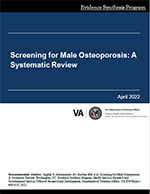
|
Recommended citation: |
Download PDF: Complete Report, Executive Summary, Report, Appendices
While screening women for fracture-related morbidity is standard practice, uncertainty remains about screening for men. Overall, few studies directly compared risk assessment tools in the same population of men limiting ability to compare across tools. Few studies reported on risk assessment tools among Veterans. Among system-level interventions to increase uptake of screening, provider education–only interventions demonstrated no increases. Yet, interventions combining patient and provider strategies, and those that allowed for patient self-referral, demonstrate effectiveness.
The USPTF has found insufficient evidence to recommend routine screening of men for osteoporosis. In addition, there is uncertainty about how to identify men for screening when warranted. This is pertinent to the VHA, given high fracture rates among Veterans. This report seeks to assess the utility of osteoporosis risk assessment tools among men; factors associated with increased risk of osteoporosis among male Veterans; and system-level approaches to boosting osteoporosis screening.
The OST has good discriminatory ability in predicting osteoporosis by DXA with 2, easily obtainable variables. Other tools evaluated by more than 1 study included FRAX, MORES, Garvan, and QFracture, and generally had widely varying discrimination. The FRAX and OST were the tools most commonly studied among male Veterans; both performed similarly with low-to-moderate discriminatory validity. Among male Veterans, we identified limited evidence of an association between individual risk factors and osteoporosis and/or fracture. For system-level approaches to increase osteoporosis screening, provider education–only interventions demonstrated no increases. Yet, provider reminders, combined patient and provider strategies, and those that allowed for patient self-referral, demonstrate effectiveness. When implementing a system of risk assessment and screening in a large healthcare system like the VA, careful consideration needs to be given to impacts on provider workflow and patient assessment burden when considering what clinical risk assessment tool to deploy.
Screening for Male Osteoporosis: A Systematic Review (Management Brief)